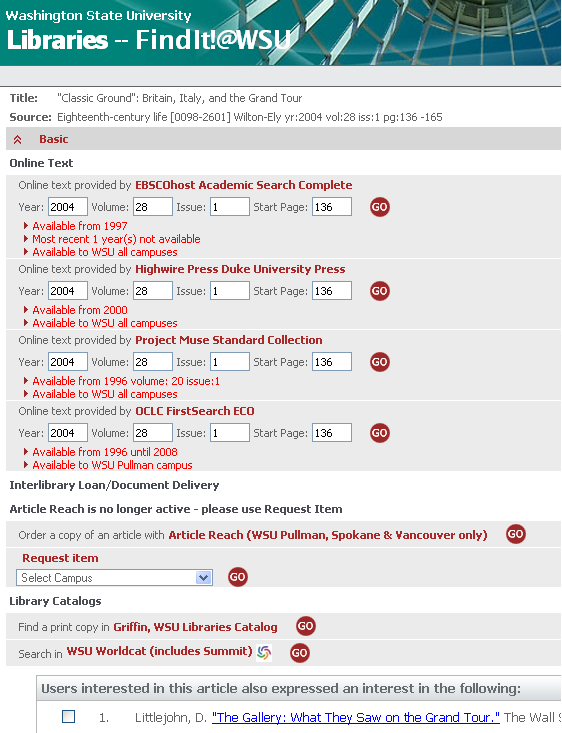|
Scholarly Journal Articles – How do I
find scholarly journal articles on historical topics?
In a sentence – you
need to consult article indexes that include historical journals. A listing
of key historical article
indexes appears below, complete
with resource descriptions and searching tips. Also, see the important confusing
terms explanations below the table.
| Name |
Description |
Searching Tips |
| Historical Abstracts |
- major
index to History journals covering all areas of world history, except
the United States and Canada, from 1450 to the present. This database
works better for Hist 121 than 120. Indexes over 2,000 journals and
covers journals printed from 1954-present |
- Truncation is
*
- Use  where available where available
- Need quotes to search phrases
- Features an extensive subject terms set
- No full-text |
| JSTOR |
- includes
the full text of over 170 History journals. Coverage is from the initial
publication of the journal to three or five years ago. Limit your search
to all the History journals or search the entire JSTOR database, with
hundreds of journals |
- Use the search
function, don’t browse
- Must select disciplines or journals for your search to work
- Only 10% of the articles have abstracts so do not search this field
- Truncation is +
- No quotes needed for phrase searching
- Nearly all scholarly/peer-reviewed materials
- Contains full-text |
| Project MUSE |
- includes the full
text of over 30 History journals. Coverage varies from the most recent
two-three years to six-seven years. You can search the entire database
or browse the journals by title, subject, or collection, such as Arts
and Humanities or Social Sciences
|
- Use
the search function, don’t browse
- Truncation is *
- Quotes needed for phrase searching
- All scholarly/peer-reviewed materials
- Contains full-text |
| Arts and Humanities
Search |
- online equivalent
of the print Arts and Humanities Citation Index, covering over 1,300
sources. The electronic version covers from 1980-present, while the
print version, located in Holland Reference, starts in 1976 |
- Always look at and follow descriptors
- Use  where available where available
- No full-text |
| Humanities International Index |
- includes
coverage of the major History journals. The online version covers from
1990-present,
while the print version goes back to 1974. Earlier resources include
the Social Sciences and Humanities Index (1965-1974) and the International
Index (1907-1965), both located in Holland Reference |
- Features tutorials within the database
- Use  where available where available
- No full-text |
Iter
(meaning path or journey in Latin) |
- index includes
citations to over 600 interdisciplinary journals covering the Middle
Ages and Renaissance (400-1700). Covers materials published 1990-present |
- First
find a WSU subscription database to search
- Six project areas to choose from
- Truncation symbol is $
- Phrases do not need quotes
- No full-text |
- What is Find It @
WSU? This searching feature helps you find the full-text of your article
of
interest. Once you click on this button, you will be presented with a
menu of options (see example below).
- The Find It service begins by attempting to find a full-text document from
another database. In the example below, there are four different electronic
options for obtaining the full-text.
- Use Request Item to place an order for an electronic or print copy of an
article.
- The Griffin catalog option is a way to try to find a print copy
of the article at a WSU library.
- Below Griffin is WSU WorldCat, which does not help you find the
full text of articles.
- Articles at the bottom of the menu are similar items.

- What is a truncation
symbol? A truncation symbol (e.g., *, +, or $) allows you to search
various endings from a root set of letters.
For example, if you
did a search for computer* you’d get back results including the words
computer, computers, computerize, etc. Truncators are one of many tools (phrase searching, Boolean Logic, field searching) you can use to improve your search queries (what you type into a search box). Go to the Search
Tips page to learn more.

|
